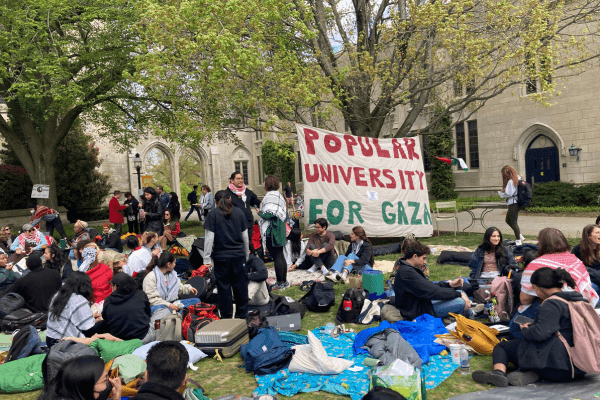MAICAO, COLOMBIA — At the hectic border crossing between La Guajira department in Colombia and Zulia state in Venezuela, there are a surprising number of kids in school uniforms – niños pendulares, or pendulum kids.
These children live in Venezuela and cross the Colombian border every day just to go to school. Brother and sister Esteban*, 10 and Estefanía*, 8, told Sojourners they get up before dawn five days a week so they can make the border crossing and get the education that their disintegrating Venezuelan state can no longer provide – and then cross back before nightfall.
Despite not being able to earn any official qualifications by doing so, the siblings say they just want the same thing as their Colombian counterparts – to go to school and to learn.
Various experts in Colombia and Venezuela said it was difficult to estimate just how many of these children there are along the length of the 1,378-mile border. In addition to the seven legal border crossings, it is estimated that there are more than 300 illegal trails called trochas, making a true headcount near impossible.
The office of the United Nations High Commissioner for Refugees (UNHCR) has been supporting programs, particularly in the border community of Maimajasay.
"Maimajasay is simply one of the many Wayúu communities on the Colombian side whose population has risen sharply due to the situation in Venezuela,” said Federico Sersale, head of office, UNHCR la Guajira. “In this school alone there was an increase of more than 100 boys and girls in the last year.”
Geoff Ramsey, Assistant Director for Venezuela at the Washington Office on Latin America (WOLA), said there could be thousands of Venezuelans attending Colombian schools throughout the country.
“Unfortunately, they can’t graduate,” he said. “There are also important gaps in the kinds of services that they receive versus those benefits that Colombian citizens get.”
Why is this happening?
In addition to Venezuela’s ongoing political and economic collapse that has seen violence soar and hyperinflation make the currency plummet, its own education system has gone from the envy of South America to a failed system in less than 10 years.
When former Venezuelan President Hugo Chavez came to power in 1998, education in the country was mostly for the wealthy and middle class, and in rural parts of Venezuela, illiteracy was still widespread. By 2005, illiteracy had dropped below 5 percent and education at all levels, including university became virtually free. There were even some education experts in the United States that saw Venezuela as a shining example.
Now this has all come crashing down – in 2018, the school dropout rate was reported by Venezuelan independent media as high as 58 percent and there have been years of power and water outages and reports of in-school robberies and violence.
Professor Ligia Bolívar, sociology researcher and human rights expert at the Universidad Católica Andrés Bello in Caracas, Venezuela, told Sojourners there are cases in Caracas where parents are teaching classes because teachers have left the country.
“The lack of teachers, the lack of continuity, there are so many disruptions – the educational system has become a poor service,” she said.
Impact on Colombia
Back in Colombia, Sojourners talked to Georgina Deluquez, director of the ‘number six’ Indigenous education centre, not far from the border, outside Maicao, Colombia. It’s the same school Esteban and Estefanía attend.
She said of the 1,000 children in the local border schools, 400 of the students were now Venezuelans who crossed the border each day.
Deluquez says during the worst of Colombia’s civil conflict, it was Colombians that were crossing the border to buy luxury goods, get health care, or attend postgraduate education.
“We are returning a debt of gratitude,” she said.
Save the Children also visited the ‘number six’ school in November 2018, to see the impact of their programs.
Maria Paula Martínez, executive director of Save the Children Colombia said they have provided school kits including a backpacks and school supplies, as well as training workshops for teachers to help them better integrate the Venezuelans, and community education communities that focus on safety and permanency for children.
Perhaps because of this history, the school hasn’t seen the ugly wave of xenophobia that Colombia’s government has been trying to tamp down in other parts of the country.
Deluquez said at first, there was some friction between the newcomers and the Colombian children, but the teachers went to special lengths to explain the circumstances and now they are part of the community.
“We don’t really call them pendulares, they prefer viajeros [travelers] but we try to refer to them by name,” she said.
The Wayúu people
Esteban and Estefanía said they hadn’t had any problems with prejudice, which might have something to do with the fact they are members of the Wayúu Indigenous group — one that, traditionally, has not recognized the border because they live on both sides.
The world at large is about to hear more about the Wayúu: In February 2019, the feature film Birds of Passage, which features Wayúu actors, will premiere worldwide after already receiving acclaim at the Cannes and Toronto film festivals.
According to Save the Children, Indigenous peoples in La Guajira represent 45 percent of the population and 20 percent of the country's Indigenous population. The Wayúu ethnic group is one of the largest in Colombia, but their traditional lands also extend into Venezuela.
“They are one ethnic group, one Indigenous group, on territory artificially divided between the two countries,” she said, “It’s probably more frequent that children go to the Colombian side for education and for health care.”
She says this phenomenon also happens with other Indigenous groups in other parts of the Venezuelan border.
Given these realities, UNHCR is working on the construction of classrooms, a school cafeteria and a water well in order to strengthen the host community and, at the same time, facilitate the integration of Wayúu children who lived on the Venezuelan side.
Through all these trials, Esteban’s love of learning has gone unabated. “My favorite subject is science!” he says with a grin.
*names changed for safety reasons
Got something to say about what you're reading? We value your feedback!








